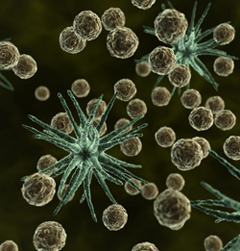
molds may trigger allergies
Typical symptoms of an allergy to molds are redness and itching, hives, conjunctivitis, sneezing and runny nose and asthma. If these symptoms, especially in the warm season, with moist warm weather, in humid areas, in rooms with mold spots or areas where plants or contact with the waste, which may be an indication of a mold sensitivity. Since molds occur regularly but in the outdoor and indoor air, to have a tentative diagnosis of “mold sensitivity” further studies are made.
Various test methods for allergies
There are several methods to test a hypersensitivity of the patient, which should be made by an experienced physician, eg with the additional designation of allergy. At the beginning of the medical diagnosis is the history, ie. the self-report of the patient about his symptoms and possible exposure sources in his life and work areas.
Often used is the prick test. Thereby a drop of the fungus extract is applied to the skin and introduced through a fine needle into the skin. The negative control used pure solvent, solvent as a positive control with histamine. A positive reaction occurs when the course of 20 minutes at the site of injection a wheal can be seen, which is as great as or greater than the histamine-induced wheal. A questionable positive reaction occurs when the course of 20 minutes at the site of injection a wheal can be seen which is smaller than the histamine-induced wheal, but greater than the wheal by physiological saline. This indicates that the patient has a Type I allergy to the mold.
If the patients symptoms of the respiratory tract that are asthmatic symptoms in the foreground, then an inhalation provocation be made. In this case, the patient initially lactose powder inhaled as a fine aerosol. Then the fungus extract is sprayed as a fine aerosol and inhaled by the patient. A pulmonary function test or a test of the sum of nasal flow before and after these provocations indicates whether the airways are narrowed by the provocation. Of a positive response is expected, if the response to fungal extract is significantly stronger than the response to lactose.
The RAST test (radio-allergological-adsorbent test) is a test tube test. He is now mostly replaced by the EAST test (enzyme-allergological-sorbent-test). The concentrations of specific IgE and IgG antibodies to allergens in a patient’s blood can be determined. During the RAST with certain allergies such as insect allergy is very meaningful, it has in the area of fungal diagnostics currently only a very limited value. Because there is a proportion of positive results in people who do not have allergies (false positive) as well as positive results in people with a mold allergy. Thus, the test result only be a small piece in the overall diagnosis. Clinically significant symptoms are to be expected in patients with a positive RAST test (EAST) test from grade 3, at very high exposures at lower RAST classes.
Only part of the fungi found indoors is standardized testable
It would be useful to examine the relevance of allergy often be more appropriate in the interior molds that were previously allergologically not testable and possibly make them commercially available standardized allergens. The specific difficulties of a clear diagnosis of mold allergy result from the fact that over 100,000 molds are known and some mold species have up to 30 allergens. As a result, the importance of individual molds in causing allergies can not be assessed fully, especially since it often isolated himself for indoor fungi often are no standardized allergen solutions in retail.
On the other molds often have immunotoxic effects that can not be distinguished clinically from allergy-related effects, so that the results of tests such as skin prick exposure or inhalation tests are to be assessed with caution. The assessment of allergy tests to molds should therefore be reserved for experienced professionals.
Text source: Landesgesundheitsamt Stuttgart: “Schimmelpilze in Innenräumen – Nachweis, Bewertung, Qualitätsmanagement”, 2001.
Picture source: www. fotalia.de #6126015 – © James Steidl
